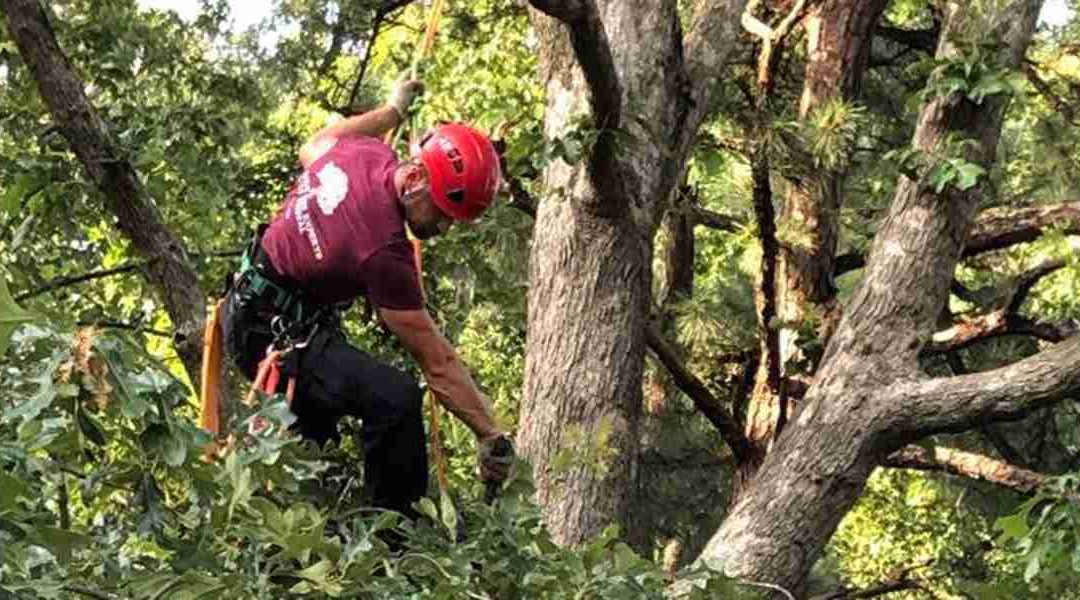Mulching is one of the simplest ways to care for our trees. It helps hold the soil around the base of trees while promoting moisture retention and nutrient uptake. Mulch also discourages weed growth and maintains healthy soil temperatures.
However, this practice is not without some downsides: Too much mulch (volcano mulching) can kill your trees. In this blog post, we look into how improper mulching can harm your trees and why you’re better off with professional mulching services in Alexandria, VA.
The Dangers of Volcano Mulching
Over-mulching can harm your plants in many ways:
Too Much Mulch Causes Root Suffocation
Over-mulching, which we also refer to as volcano mulching, is notorious for suffocating plant roots. When you apply an overly thick layer of mulch around your plants, you’re actually laying the ground for waterlogging in the root zone.
This leads to oxygen deficiency. When oxygen content in the soil falls below 10%, root growth will slow down and eventually die. Your plant wouldn’t survive with dead roots.
It Promotes Bacterial and Fungal Diseases
Inadvertently piling mulch next to your tree’s trunk can lead to fungal and bacterial ailments entering the stressed, decaying bark tissue. Once the disease takes root, even the mildest infections can eventually kill the inner bark, cutting off the nutrient supply to the roots. You’ll end up with a dead plant!
Piles of Mulch Generate Deadly Heat
When you pile layers of wet mulch against the stem tissues, it will eventually start to decompose and generate excess heat in the process.
The inner mulch layers can reach temperatures as high as 140° F, and a young tree or shrub phloem can’t survive such heat.
Mulching Volcanos Create Homes for Rodents
When you place thick layers of mulch adjacent to your tree trunks, you provide a conducive hideout for chewing rodents that will eventually kill your plants.
Rodents like meadow voles and small mice will create a home under the warm mulch during the cold season and chew on the tender, nutritious inner bark to access sugars for their survival.
Over-mulching Contributes to Nitrogen Deficiencies
Last but not least, fresh or no-aged mulches often lead to nitrogen deficiencies in young trees and shrubs. Decomposing fungi and bacteria that ultimately break down mulch needs sufficient nitrogen supply to work efficiently.
Unfortunately, the mulches we use for landscaping often comprise wood or bark with little nitrogen content, so the soil bacteria use the existing nitrogen to break the mulch down. This process may result in inadequate oxygen for new growth.
Some of the common symptoms of plant damage from over-mulching include:
- Unusually small leaves
- Unhealthy twig growth
- Off-color foliage
- Die-back of older branches
Keep in mind that these symptoms don’t show up overnight. They may take at least three years to appear, depending on the tree species and mulch type. Regrettably, we often notice the problem when it’s too late to save the tree.
What Is the Right Amount of Mulch to Use?
Excessive mulch can prove fatal to your plants, but how much mulch is too much? Tree care experts recommend piling mulch no more than 3-4 inches deep.
Be sure to steer clear of the tree base, creating a ‘donut shape’ with the mulch around the tree.
Contact Your Local Tree Experts for Assistance
Now that you know that too much mulch can be problematic for your plants, consider leaving the task to professionals to avoid any headaches. Dos Amigos Tree Experts are your trusted local arborist for all tree care needs in Alexandria, VA.
Contact us at (703) 300-6103 for more information and to learn about the benefits of mulch around trees.


